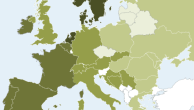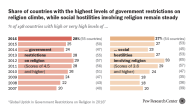Compared with some other economically advanced countries, religious commitment in the United States is exceptionally high. When it comes to daily prayer, religion’s importance in people’s lives and weekly attendance at worship services, Americans of both genders display greater religious engagement than their counterparts in Canada, Germany, Australia, France and the United Kingdom, Pew Research Center data show.28
For example, 64% of American women and 47% of American men say they pray daily. Of the five other economically advanced countries analyzed, Canada comes closest to the United States on this measure; 30% of women and 28% of men in Canada say they pray daily. In France, by comparison, 15% of women and 9% of men report praying daily. Similar patterns are seen on the measures of religion’s importance and attendance at worship services: American men and women both display higher levels on these measures than men and women in the five other countries.
The U.S. also stands out for having consistently wider gender gaps than any of the other five countries.29 In daily prayer, religion’s importance and weekly attendance at worship services, American men and women differ from each other to a greater extent than men and women differ in Canada, Germany, Australia, France and the United Kingdom (see below graphic).
Looking at daily prayer, for example, the 17-percentage-point gap between American women and men (64% vs. 47%) is nearly double the 9-point gap in the United Kingdom (23% vs. 14%), and it dwarfs the 2-point gap in Canada (30% vs. 28%).30 The measure on importance of religion displays a similar pattern. Fully 60% of American women say religion is very important in their lives, as do 47% of men, a 13-point difference. Meanwhile, in the United Kingdom, women and men differ on this measure by only 6 percentage points (24.7% vs. 18.3%); in Australia the gap is only 7 percentage points (21.3% vs. 14.7%). Gender differences on religion’s importance are even smaller in Canada, France and Germany.31

A similar pattern is seen when differences between men and women in the United States on various measures of religious commitment are compared to average gender differences found in Pew Research Center surveys in up to 83 other countries. The U.S. gender gap is often larger than the average.
In daily prayer, for example, the 17-point gap between U.S. men and women far exceeds the average 7-point gap across 83 other countries. Similarly, the 13-point gender gap between American men and women in the importance of religion is considerably larger than the 5-point average gap across a similar number of countries. In both cases, the U.S. gender gap is not the largest of all countries, but it is above average.32
The United States has the largest Christian population in the world (more than 243 million as of 2010). On several measures, gender differences among U.S. Christians are either similar to or larger than the average differences among Christians in about 50 other countries.
For example, 50% of Christian women and 44% of Christian men in the United States say they attend worship services at least once a week. This 6-point gap is close to the average gap of 7 percentage points among Christians surveyed on this measure in 52 other countries. In the case of prayer, 75% of Christian women and 61% of Christian men in the United States say they pray daily. This 14-point gap is larger than the average gender gap of 10 percentage points among Christians surveyed in 53 other countries. Likewise, the 10-point gap between U.S. Christian women and men when it comes to importance of religion (73% vs. 63%) is larger than the average gender gap of 6 percentage points among Christians across the 53 other countries where data are available on this measure.
In many countries outside the United States, the religiously unaffiliated share of the population is not large enough to garner a sufficient number of survey respondents (300) for reliable comparison between men and women. However, there are 13 countries with sufficiently large unaffiliated populations, including the United States, where such analysis is possible. Data from Pew Research Center surveys in these countries indicate that the gender gaps among unaffiliated Americans generally are larger than the overall averages from the 12 other countries.
For example, 26% of unaffiliated women and 15% of unaffiliated men in the United States say they pray daily, an 11-point difference. The average gap across the 12 other countries on this measure is 3 percentage points. Uruguay, however, has a larger gender gap than the United States on daily prayer among its unaffiliated population: 14% of unaffiliated women and 2% of unaffiliated men in Uruguay report praying daily, a 12-point gap. When it comes to religion’s importance, 15% of unaffiliated women and 12% of unaffiliated men in the United States say it is very important to them. This 3-point gap is slightly more than the average gap of 1 percentage point across 12 other countries.
In the United States, 5% of unaffiliated women and 3% of unaffiliated men attend religious services weekly, a 2-point gap. The average gap across 10 countries is less than 1%.33




